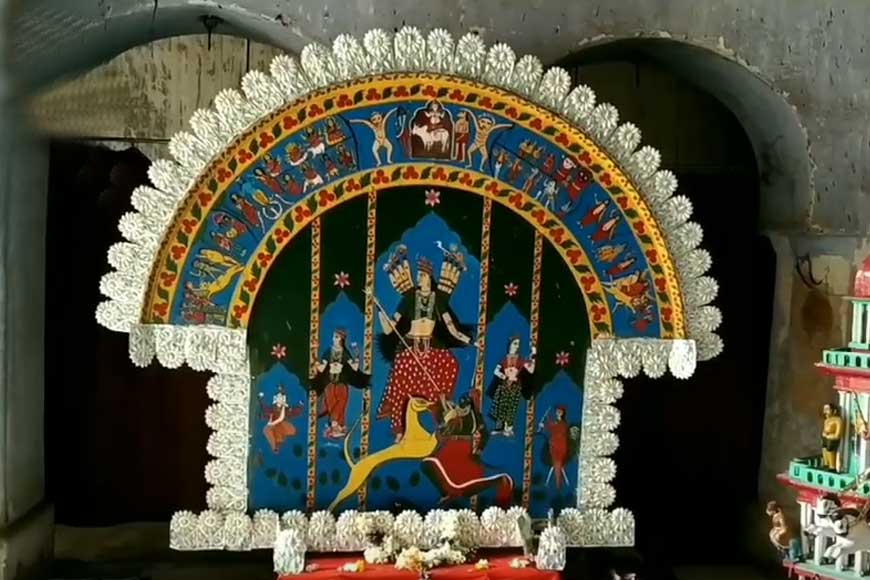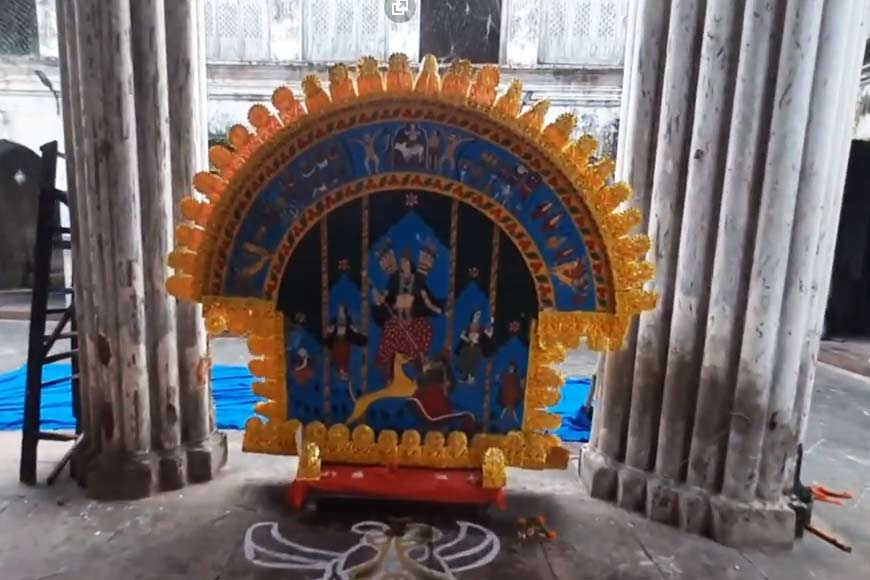Durga worshipped as Pateshwari Devi at Burdwan Rajbari

The zamindari of Burdwan was one of the largest and richest feudal estates in the Bengal province that flourished from about 1657 to 1955. The erstwhile rulers of Burdwan have been hosting Durga Puja at their family temple which is also the abode of their ‘kula-devata’ (tutelary deity), Lakshminarayan Jiu for the past 350 years. Durga Puja was initiated by Maharaja Mahatab Chand (1820 -1879), who was an efficient ruler under whose leadership Burdwan estate attained great prosperity. He was at the helm of affairs when the British Crown assumed power in 1858. It is very interesting to trace the evolving history of Durga Puja rituals at Burdwan Rajbari and the puja itself is unique in many aspects. The royal lineage of the Burdwan royal family can be traced to a Khatri Punjabi merchant who came to Bengal in the 17th century and acquired land and power under the Mughals.
Sangam Rai Kapoor, a Khatri merchant from Kotli, Punjab, was the first member of the family to settle permanently in Burdwan. On his way back from a holy pilgrimage to Puri, he made a stopover at Baikunthapur, a village near Burdwan. He found the location of the village viable for expanding his business. So, he settled down at Baikunthapur and devoted himself to commerce and money lending. He soon made a name for himself and prospered. His grandson Abu Rai, during whose time the zamindari started flourishing, is considered to be the patriarch of the Burdwan Raj family.
The Durga Puja that was initiated by Maharaja Mahatab Chand about 350 years ago, is still celebrated d with great fervour even to this day. The grandeur of the festival may have toned down, but all puja rituals are strictly observed. Here the goddess is worshipped as ‘Pateshwari’, and she is represented in the traditional, cloth-based scroll painting. The deities are elaborately decorated with ornaments made of sola (the pith of a shrub). The painting is framed with Sal tree (Shorea robusta) wood. Devi Durga is depicted as the warrior goddess, mounted on a lion (that resembles a horse though), annihilating Mahishasur. Lakshmi, Saraswati, Ganesh and Kartik are also in the frame. However, one very interesting aspect of the ‘patachitra’ is that, all the deities, other than Ganesh, are shown looking sideways. So viewers get to see only a side profile of the deities. The painting is given a makeover after every 12 years. This ritual is known as ‘Anga-raag.’ Durga is worshipped here as Maa Chandi. Chandika is the name by which the Supremely divine is referred to in Devi Mahamaya. Chandi is defined as 'the angry, terrible or passionate one' and represents the Shakti or power of Brahman. The goddess is worshipped for nine days in the nine avatars of Shakti.

During the heydays of Burdwan empire, Pateshwai Puja was celebrated with great fanfare and people from distant places congregated in large numbers to participate in the Lakshminarayan Jiu ‘Thakurbari’ (shrine) complex, the venue of the annual autumnal festival. Many people travelled long distances on bullock carts or walked for miles and crossed the Damodar River to join in the revelry. The temple would be crowded every day during the nine days of puja. According to royal customs, ladies of the royal family were barred from appearing in public. So, they would use a secret route to enter the temple and settle themselves in the first floor ‘Zenana Mahal’ (the ladies’ chamber) and watch the proceedings from behind curtains, away from prying eyes of the commoners.
Maharaja Mahatab Chand built a huge ‘Thakur dalan’ (public courtyard, with pillars and verandahs) in the palace when he started the Pateshwari Devi’s puja but over time, the courtyard collapsed and the venue had to be shifted to the Lakshminarayan Jiu ‘Thakurbari’ (temple) adjoining the palace. All the rituals are followed meticulously during the nine-day festival. Puja begins at the Burdwan palace from Pratipada, the day after Mahalaya. The day heralds Navaratri festival at the palace. During Navaratri, the Goddess is worshipped in each of her nine forms, with each day having a different set of rituals. During the puja, the present descendant of the family, Prince Pranay Chand Mahatab along with his wife stay at Burdwan and he participates in the rituals along with the family’s sevayat (priest), Uttam Misra, who conducts the puja. All the expenses of the puja are borne by a trust created for this purpose. The trust also looks after the maintenance of the temple for the rest of the year.
Although the puja is conducted according to Vaishnav traditions, ‘boli pratha’ (animal sacrifice) is a vital part of the puja ritual. However, no animals or birds have ever been sacrificed at the altar. During Maharaja Mahatab Chand’s reign, betel nuts were ‘slaughtered’ as a symbolic gesture. Later, betel nuts were replaced by ash gourd. On the eighth day (Ashtami), ‘Mohun-bhog’ is offered to the goddess. On both Ashtami and Navami, the deities are offered elaborate ‘Bhog’ that include, among other foodstuff, puri, chana and halwa (an indigenous sweetmeat). This is ten offered to all devotees. During the heyday of Burdwan kingdom, 51 types of food items were offered to Devi Pateshwari during the puja.
On Navami, Nava Kumari puja is performed in front of Pateshwari Devi. In the evening, the temple complex reverberates with the sound of folk music as Guajarati men and women of all ages, troop in in colourful attires and perform ‘Garba and Dandiya dance.’ Garba and Dandiya, both are performed during Navratri because these dance forms are a dramatization (sort of like a mock-fight) of the nine-day battle between Goddess Durga and the demon king Mahishasura, in which the Goddess emerged victoriously. This is what Navratri symbolizes as well - the triumph of good over evil, even if that evil stems from our own cluttered and undisciplined mind. These nine days give us a chance to purify negative thoughts and start afresh. The temple complex gets very crowded during the performance and devotees sway to the rhythmic music and many join in the dance rituals as well.
It is only during these nine days that the dilapidated, old temple comes alive. Tucked away deep inside the narrow winding lanes of Burdwan city, this shrine was once part of the royal household, but ‘Time’ has been a ruthless leveler. The temple is now under thick foliage, its ornate stone pillars and arches showing the ravages of time with fading paint and widening cracks. There are traces of beautiful terracotta inlay works inside the premise, but most of them are damaged. The vestiges of the mighty Burdwan kingdom lies in a rickety state, gasping for breath.










